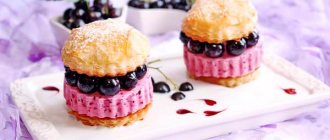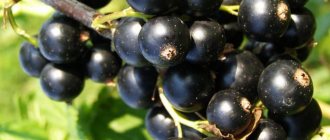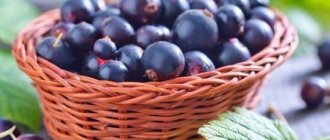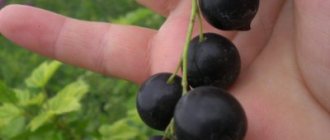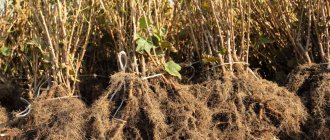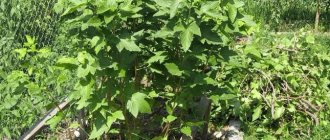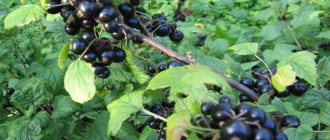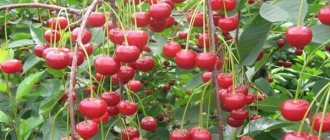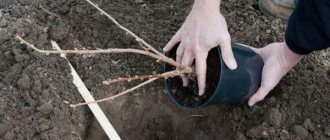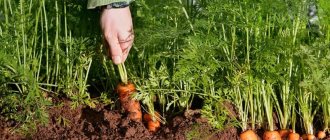Blackcurrant variety Dobrynya: reviews, photos, description
Black currant is widely known for its healing and beneficial qualities - its berries contain large amounts of ascorbic acid, other vitamins and minerals, as well as active substances beneficial to the human body. Its leaves also contain many useful substances. Therefore, this fruit shrub can be found in almost any garden plot. And even if the size of the garden is small, there is always room for one or two blackcurrant bushes.
Below we will talk about one of the relatively new varieties of black currant - Dobrynya, bred by Russian breeders.
This fruit shrub is already quite widely known and popular among Russian gardeners from different regions of the country. Positive characteristics, productivity, nuances of growing Dobrynya currants and much more - all this is presented in this article.
The content of the article:
1. History of the variety 2. Description of the Dobrynya currant variety 3. Dobrynya currant - yield of the variety 4. Diseases and pests 5. Positive features of the variety 6. Planting and growing the Dobrynya variety 7. Caring for currants in open ground 8. Rules for fertilizing currants 9. Pruning Dobrynya blackcurrant (+ video) 10. Reviews of Dobrynya currant
Treating bushes against pests and diseases
Dobrynya currant bushes are almost never affected by diseases. But pests can cause them considerable harm. Most often, signs of aphids, mites, and moths can be seen on the leaves. To destroy them, insecticides such as Nissoran, Lepidotsid, Akarin, Bitoxibacillin are used.
Insecticides are used to kill pests on currants.
To prevent diseases and pests, it is necessary to regularly trim the bush, check the condition of the leaves, and remove weeds that may appear under the bushes. It is also important to remove all fallen leaves and burn them, as they may harbor dangerous insects. It is also recommended in the spring, before the buds open, to water the bushes with boiling water (70 degrees). It destroys all beetles, and even some diseases that can overwinter on the bush.
Important!
If the black currant Dobrynya still gets sick, despite its strong immunity, it must be treated with “Bordeaux liquid” or a preparation like “Profi Plus”, “Baktofit”, “Bayleton”.
History of the variety
A well-known scientist and breeder from the All-Russian Research Institute of Lyupin, A. I. Astakhov is the author and originator of many popular and wonderful varieties of berry crops and fruit trees. The decoration of the “collection” of varieties bred by him is the black currant Dobrynya with decent yield, large sweet berries, which can be grown in most Russian regions.
This new variety was obtained as a result of crossing the Izyumnaya currant and the cultivar-linear hybrid 42-7. From the first “parent” Dobrynya berries received a wonderful sweet taste.
Important!
Dobrynya currants were included in the Russian State Register in 2004; they were recommended for cultivation in the Moscow region, the middle zone, regions with similar climatic conditions, as well as in the southern regions of Russia.
Over time, bushes of this flock variety will be grown in other regions of the country. And currently, Dobrynya currants can be found in most Russian regions, where they bear fruit well and do not freeze out in harsh winters.
Harvesting and storing currants
The first harvest can be harvested at the end of July. The last berries ripen by the end of August. The berries do not ripen en masse, but in stages, so they are harvested approximately once a week. After picking, currant berries can remain in the refrigerator for up to a week, but the softest of them begin to deteriorate in the first days.
Berries are universally used, can be used for making desserts, canning, compotes and juices
Universal berries. They can be consumed fresh, used for making desserts, canning, compotes and juices. Various tinctures and wine are also made from these berries. Dobrynya currants do not lose their beneficial properties and taste after freezing and drying.
Coniferous cypress tree: detailed description and photo of what it looks like
Main characteristics and description
The bushes of this berry crop are compact, the shoots are erect, not bending to the ground even under the weight of the harvest. The crown of the Dobrynya currant is neat, compact, and not spreading. The height of the shoots can reach 1.7 m; this figure directly depends on the climatic conditions of the area in which it is grown.
Important!
The Dobrynya variety has an unusual color of young branches, different from the color of the shoots of other varieties of black currant. The color of the bark is purple with an olive tint and a characteristic shine. The thickness of the stems is medium, covered with light pubescence.
The foliage is five-lobed, dark emerald green, wrinkled. Leaf blades can be of different sizes, with clearly visible serrated cuts.
The blooming buds are pale yellow in color, small, collected in racemose inflorescences, each of which can bloom up to 8-10 flowers. Clusters of Dobrynya fruits are loose, formed at the ends and middle of the shoots.
Photo of currant variety Dobrynya
The berries of the Dobrynya variety are quite large, can reach 6-7 g. The fruits are oval in shape, the skin is dense, smooth and elastic. Therefore, the fruits are not prone to cracking even in rainy weather.
Interesting!
When the berries are torn from the stalks, the tearing area will always be dry. Collected currants are aromatic, sweet, and the percentage of acid in them is low. Tasting rating of currants – 4.8 points out of 5 possible.
The fruits can be used for fresh consumption, as well as for making preserves, jellies, jams and compotes. When Dobrynya currant berries are frozen, they retain all their beneficial qualities after defrosting.
Comment!
Dobrynya currants are highly resistant to cold weather - they do not need to be covered in those regions where the thermometer does not drop below -25 degrees Celsius in winter. In colder areas, this berry requires shelter before the onset of frost.
Spring cold snaps or short droughts during the summer do not negatively affect this variety - the perennial does not shed either flowers or fruits under unfavorable conditions.
Advantages and disadvantages
The described hybrid has its pros and cons. The first signs include the following qualities:
- Bush, compact with a small crown and upright. This combination allows you to use less space for planting, therefore, you can plant more bushes.
- An important advantage is the large-fruited and early ripening of the variety. The latter quality is expressed in the fact that the very next year after planting, Dobrynya will please the gardener with a full harvest.
- The harvest is stable, regardless of the weather.
- The fruits are suitable for consumption in any form: fresh, preservatives. Even frozen they do not lose their beneficial qualities.
- Dobrynya has high winter hardiness. Thanks to this ability, it easily tolerates winters with temperatures not lower than -25. If winter temperatures are much lower, then shelter will be required, in which case it can easily tolerate frosts of 45 degrees.
- Neither spring frosts nor summer drought can cause much harm to the variety. It does not lose flowers or ovaries.
- Despite the low yield, the variety is very attractive for industrial cultivation. After all, the demand for Dobrynya berries is always high.
There are also disadvantages:
- For a modern hybrid variety, the yield is extremely low. However, it cannot be increased in any way.
- Transportability on an industrial scale is low. Because due to their weight, the berries crush each other.
- The formation of roots in seedlings is excessively slow, which greatly reduces the percentage of successful establishment. To improve it, it is recommended to use a stimulant.
- Excessive susceptibility to kidney mites.
- Asynchronous ripening of berries. Because of this, they are collected in several stages.
We recommend that you familiarize yourself with the features of agricultural technology for the Golubka currant in this material.
Berry composition
One hundred grams of berries contains:
- sugar – 6.0-9%;
- titratable acidity – 2.5%;
- ascorbic acid 200 mg.
Application
The variety is universal, well suited for cultivation on an industrial scale and in private farming. The same can be said about the red currant Roland.
Recommended for fresh consumption, in the form of various preservatives - preserves, juices, compotes, jams. Berries can also be deep frozen without losing their quality.
In addition to eating, the berries are used in folk medicine and cosmetology.
Diseases and pests
The bushes of this blackcurrant variety are highly resistant to powdery mildew. Dobrynya's resistance to other diseases is average; this berry crop can also be affected by the bud mite.
It is important to know!
It is recommended in early spring, before the buds begin to open, to treat the bushes with Bordeaux mixture, a solution of copper sulfate or weak potassium permanganate. Also, preventive spraying is carried out in the fall, after all the foliage has fallen from the shoots.
If signs of disease appear on the foliage and stems of currants, then they will have to be combated with a solution of appropriate fungicidal preparations.
Characteristics of black currant
Over 12 years of cultivation, Dobrynya acquired an excellent reputation. It can easily withstand frosts down to 25 degrees, and in shelters below 40 degrees. Resistant to spring frosts. It does not die during prolonged drought, although the berries become smaller without watering.
It has a good yield of 1.6 to 2.4 kg per bush. Due to the fact that the bushes are not tall and can be planted at a distance of 80 cm, they produce more fruits per unit area. The variety is early-bearing and pleases with the first fruits the following summer after planting. In rainy years the fruits remain sweet. Is immune to powdery mildew and bud mite. Fruits annually and abundantly.
Video: fruiting of Dobrynya
Positive features of the Dobrynya currant variety
The main advantages of the Dobrynya blackcurrant variety are as follows:
- the bushes are compact, the shoots are not spreading, so there is more space left on the site for planting other crops;
- large berries and their early ripening;
- Dobrynya currant begins to bear fruit the very next year after planting;
- stable yield and taste of fruits regardless of changes in weather conditions;
- universal purpose of the harvested crop;
- the possibility of growing Dobrynya currants without shelter when planting in regions with winter temperatures up to -25 degrees Celsius. In colder winters, bushes need to be covered;
- unfavorable weather conditions do not affect the bush - the plant does not shed flowers and fruits;
- the yield of the berry perennial Dobrynya is at an average level;
- The Dobrynya variety is highly resistant to powdery mildew.
Currant Dobrynya - video
But this variety of currants also has a number of disadvantages:
- the yield is not too high for modern varieties;
- the harvested Dobrynya currant crop does not tolerate transportation well, as the fruits are very wrinkled and caked;
- The shrub slowly develops a root system, so there may be problems with adaptation to a permanent location;
- Dobrynya currant has low resistance to bud mite damage.
Description of the variety
Black currant Dobrynya is a large-fruited variety distinguished by the high taste of its fruit. Plants are resistant to temperature changes, in particular to frosts down to –25°C and droughts. The variety is popular among gardeners and receives a lot of positive reviews.
Did you know? Currants grow on almost all continents. The exceptions are Antarctica and Australia.
History of selection
The black currant variety Dobrynya was bred at the All-Russian Lupine Research Institute. The main breeder of the variety is A.I. Astakhov.
When developing the variety, we crossed the Izyumnaya variety and No. 42-7. Dobrynya currant was included in the State Register of National Breeding Achievements in 2004.
Appearance, characteristics of berries, ripening time, yield
Currant Dobrynya has the appearance of a compact bush with upright growing shoots. The branches are medium thick, slightly pubescent, slightly shiny. The stems have large green leaves. During flowering, buds with light yellow petals open.
The berries ripen weighing 5.5–6.5 g. The fruits are oval in shape. The peel is black, strong, shiny. The pulp is dense, sweet and sour in taste with an aromatic aftertaste.
The chemical composition of berries:
- vitamin C - 200 mg per 100 g;
- acidity - 2.5%;
- sugar - 6.9%.
The ripening period of the variety is average. Gardeners harvest 1.6–2.4 kg of crop from the bush during the growing season.
Did you know? Green currants contain 4 times more ascorbic acid than ripe ones.
Advantages and disadvantages
- The Dobrynya currant variety has many advantages:
- compactness of the bush;
- large fruits;
- high taste qualities of the crop;
- stable fruiting;
- universal application;
- frost resistance down to –25°С;
- drought resistance;
- resistance to powdery mildew.
- Farmers cite the following characteristics of the crop as disadvantages:
- average yield;
- low or average resistance to most diseases and pests;
- long-term rooting of seedlings after planting;
- the need for anti-aging pruning.
Black currant Dobrynya: planting and growing varieties
In order for the purchased Dobrynya seedlings to take root well, you should plant them correctly:
Important!
Planting pits are prepared in advance. Their diameter should be at least 0.55 m, and their depth should be up to 0.4 m. The distance between adjacent holes should be at least 1.5 m so that the plants do not interfere with each other during the growth process and do not “fight” for nutrients. The row spacing is usually about 2.25 m. When Dobrynya shrubs are planted this way, it is easier to care for them, and the plants get sick less often.
This berry perennial requires a large amount of nutrients in the soil. Therefore, when planting, add 0.5 buckets of humus and 1 cup of wood ash to each hole.
Immediately before planting, the roots of Dobrynya currant seedlings are inspected, all dry and damaged shoots are removed, and the cut areas are powdered with crushed charcoal.
The seedling is placed in a hole, distributing the roots over the entire diameter of the hole. When planting, the plant should be positioned at an angle of 45 degrees.
When filling the roots with nutrient substrate, you need to ensure that the root collar is 6-8 cm above ground level. The soil is carefully compacted. Then 1-1.5 buckets of water are poured under each currant bush.
At the final stage of planting Dobrynya currants, each tree trunk circle is mulched to prevent rapid evaporation of moisture.
Compost, dried grass or sawdust are usually used as mulch.
Planting Dobrynya currants
Landing rules
The plant reproduces vegetatively. For good survival of currants and successful growing season, select a seedling with a developed root system, observe planting dates, and select a site with soil suitable for the variety.
Recommended timing
Currants are propagated in spring and autumn. In the first case, seedlings are planted after the soil has warmed up, around the beginning of May. Autumn planting is carried out 3 weeks before the onset of frost. Focus on climate features. For the Middle Zone this is the second half of September. In autumn, currants are bred by dividing the mother bush.
Choosing a suitable location
Site requirement:
- open sunny place, partial shading is allowed;
- lack of nearby groundwater;
- spring drainage is recommended;
- suitable soil composition: slightly acidic, fertile, medium loamy.
Before planting currants, the area is dug up, sand, wood ash, and compost are added.
Selection and preparation of planting material
Buy black currant seedlings “Dobrynya” for two years; they have a better formed root system. Attention is paid to the appearance of the planting material; the bush should consist of three or more stems with smooth bark without damage. The presence of healthy fruit buds is a must. The roots should be free of dry and broken fragments.
The division of the bush is carried out after the leaves have been shed. Before moving blackcurrants to a new location, cut off the old stems and leave three one-year-old shoots. The mother plant must be at least three years old. Before placing the “Dobrynya” currant variety on the site, the roots are dipped in a growth stimulating solution (“Kornevin”) for a day.
Landing algorithm
Before planting the Dobrynya currant variety, prepare a mixture of equal parts of peat and turf soil, add urea (100 g per hole). Subsequent landing:
- The planting hole is 45 cm deep, 0.5 m in diameter.
- A fertile mixture (20 cm) is placed at the bottom.
- Place the seedling at an angle of 450, distribute the root evenly.
- Fall asleep, leaving 6 cm above the surface to the root collar.
- The soil is compacted carefully so as not to damage the fibrous shoots, and watered.
- The root circle is mulched with organic matter.
Caring for currants in open ground
Further care for Dobrynya currant bushes includes:
- regular watering;
- fertilizing;
- loosening of tree trunk circles;
- weeding;
- pruning;
- preparing shrubs for winter.
The taste and size of the fruits of the Dobrynya variety directly depend on a well-designed irrigation regime.
If there is a lack of moisture, the berries become hard, and if there is too much, they can crack. Stagnation of moisture in the soil usually leads to rotting of the currant root system and the death of the plant.
Interesting article:
Preparing currants for winter - autumn shrub care.
Rollers of soil are made along the edge of the tree trunk circles so that water does not flow out when watering. Water black currants once every 2-3 weeks (depending on weather conditions). A bucket of water is poured under each bush in one watering.
But during certain periods of development of the perennial shrub Dobrynya, it requires a large amount of water (up to 40 liters):
- in the second ten days of May, when the berries begin to set;
- from the beginning of June, when the fruits begin to ripen;
- after leaf fall when carrying out moisture-charging irrigation.
Black currant Dobrynya. Plant care
Currant Dobrynya: photo
You need to care for planted plants like this: water, feed, loosen the soil, weed, trim, prepare for wintering.
Watering
The more regularly and competently watering is carried out, the better the taste and harvest will be. If there is not enough moisture, the fruits will become tougher. And if there is an excess amount of water, they will crack. Moreover, an excessive amount of moisture can lead to rotting of the roots, and the bush will die.
Watering is done in circles around the trunk. To prevent water from leaking out, grooves with high sides are made in a circle. Water once/2-3 weeks. You need to pour up to 20 liters of water under the root.
During some growing seasons, currants need a lot of water, up to 4 buckets for one bush.
When:
- on the 15th of May, when the fruits begin to set;
- in the first summer month, when the fruits begin to ripen;
- During the winter season, when the currant leaves fall off, water with enough water.
Feeding
Like other varieties of currants, the Dobrynya variety requires nutrients. Those fertilizers that were applied during planting are valid only for one season. If soil nutrition is reduced, this will have a bad effect on yields and bush formation.
At what time and with what should you fertilize?
In the spring, pour 50 g of urea into a circle near the trunk. In advance of this procedure, you need to water the soil well to prevent the roots from being burned by fertilizing.
When brushes begin to appear on the bushes, the bushes are fertilized with mullein, a solution of bird droppings.
During the flowering of the plant, it must be fed with organic substances 2 times: mullein infusion, bird droppings solution or herbal infusion, nettle solution.
During the period when flowers appear on the bushes, spraying is done to stimulate fruit set. Solution: copper sulfate (10 g), boric acid (2 g), potassium permanganate (5 g) dissolve in 10 liters of water. One bush requires 2-3 liters of fertilizer. After complementary feeding, the fruits will become larger and sweeter.
When green fruits form on the clusters, the bushes are provided with good watering with clean water in a circular groove, and bird droppings are added.
Before the winter season, bird droppings or compost fertilizer (2-3 kg per bush) are applied under the bushes, but these fertilizers are not placed in the soil. During the winter period, this complementary food will have time to decompose and become preparation for the new growing season.
Currants can also be fertilized with folk fertilizers.
Throughout the summer season, plants are watered with bread kvass; it is necessary to add 2-4 liters under each bush or bury soaked bread or bread that has fermented.
Potato peels are laid around the bush.
Legumes are good green manures that need to be buried in the soil in the autumn season.
Legumes will saturate the roots with nitrogen and encourage beneficial soil bacteria to take action. Rules for pruning Dobrynya currants
To ensure stable yields every year, the bushes require rejuvenating procedures. The shoots bear fruit for no more than 5 years, then the harvest disappears. For this reason, old branches are pruned every year to the very root.
Each bush should contain shoots of different ages. Young seedlings are shortened by 15 cm in order to have lateral branches appear on them.
The root system, if it grows too much, is pruned throughout the summer. Only strong shoots are left to compensate. In the spring, the plant should be pruned before the sap begins to flow, from the moment the soil thaws.
Rules for fertilizing Dobrynya currants
Black currant is very demanding on the nutritional value of the soil, the Dobrynya variety is no exception, so it should be fed according to a certain scheme:
- in the spring, apply 2 tbsp under each bush. l. dry urea. Before applying fertilizer, watering must be carried out so that the fertilizing does not burn the tender roots of the currant;
- during the period of formation of brushes, you need to add organic matter to the soil - cow manure or chicken droppings infused for several days in water;
- When flowers begin to bloom on the shoots, the currants are fertilized twice with an organic solution. You can use cow manure, bird droppings, greenfinch or nettle infusion;
- To stimulate the formation of ovaries, foliar feeding should be done - foliar feeding improves the yield and taste of Dobrynya currant berries. To do this, 10 g of copper sulfate, 2 g of boric acid, and 5 g of potassium permanganate are diluted in a bucket of water. For each bush, 2.5-3 liters of solution should be used;
- after the berries are formed, the tree trunk circles are watered abundantly and bird droppings are added;
- Before the start of winter, up to 3 kg of bird droppings or compost are added to each tree trunk circle, which does not need to be embedded in the ground.
Video about pruning black currants
Landing Features
As already noted, the Dobrynya currant variety has problems with reproduction; seedlings do not always take root. Let's take a step-by-step look at how to plant blackcurrants correctly.
Stages:
- The hole is dug in advance. It should be 40 cm deep and 50-60 cm wide. Seating should be located at a distance of about one and a half meters to ensure sufficient air circulation. Row spacing is left within 2-2.5 meters. With this scheme it is convenient to care for the bushes. In addition, plants get sick less often.
- Blackcurrant is demanding on the soil. It must contain enough nutrients, so about 150 grams of wood ash and up to 5 kg of compost or humus are added to each hole.
- Before planting, be sure to inspect the root system of the bush. If there is damage, it is better to discard the seedling. The roots need to be distributed throughout the hole.
- It is better to plant currants together. In this case, it will be more convenient to hold the bush at an angle of 45 degrees. An assistant fills the seedling with soil. The root collar should not be deeper than 8 cm, and the fruit buds should be flush with the surface.
- The soil around the Dobrynya currant seedling is trampled down to release air from under the roots.
- 10-15 liters of water are poured under each bush.
- Immediately mulch the plantings to retain moisture. You can use compost, dry grass, rotted sawdust.
Pruning black currant Dobrynya
Pruning of currant bushes can be formative, sanitary and rejuvenating. It must be remembered that on the shoots of Dobrynya black currant alone, a harvest of no more than 5 seasons is formed, then it is necessary to cut out the old branches at the root.
Important!
Each currant perennial should have shoots of different ages. Young branches are shortened by 13-15 cm to activate the growth of side shoots.
The root shoots of this currant should be cut out throughout the summer, leaving only a few of the strongest replacement shoots.
In the spring, sanitary pruning is carried out before sap flow begins. In this case, frozen, dry, damaged and broken shoots are removed, and the cut areas are disinfected with coal powder.
Features of agricultural technology
The growing technique itself is practically no different from the procedure for growing black currants. With rare exceptions associated with the early fruiting of the bush.
A description of the currant variety Dachnitsa can be found in this article.
Landing
To store pre-prepared seedlings, it is recommended to use a room with a low temperature. If the seedling begins to grow buds, it means that the temperature is not low enough.
Deadlines
Each region has its own deadline, but there is one thing in common - seedlings are planted in open ground as soon as the danger of returning spring frosts has disappeared. It's spring.
Planting can also be done in the fall. In this case, it is necessary to do this about three weeks before the onset of frost. Again, they focus on the characteristics of the regional climate.
For the Middle Zone: in spring at the beginning of May, in autumn - the second half of September.
Selection of seedlings
The sprout for planting must be at least two years old. Younger seedlings have a less developed root system.
Pay attention to the appearance of the future bush - the bark must be intact, at least three stems on the root and the presence of healthy fruit buds. Also inspect the root system - they should not be dry or broken.
You can also prepare a seedling yourself by dividing an adult bush. The procedure is carried out in the fall, after the bush has shed all its leaves. This is done with shrubs that are at least three years old. All old shoots are cut off, leaving only three one-year-old shoots.
It is recommended to soak the roots of the seedling for a day in a solution of a growth stimulator before planting.
Preparing the landing site
The place should be well lit; Dobrynya feels good in the shade. Just a lack of light negatively affects the harvest, more precisely its quantity, weight and taste. Therefore, the best option would be to plant the bushes in an open place, well protected from the winds.
The soil
The land must first be cleared of all weeds and must be fertile.
Distance between bushes
Thanks to the compact crown, you can leave about 80 cm between the bushes. When planting the Rovada variety, you must maintain the same distance. This allows you to save some space and plant more plants. One and a half to two meters are left between the rows; the distance should be sufficient so that harvesting does not cause inconvenience.
Landing algorithm
It is worth remembering that Dobrynya has a problem with survival. Therefore, these requirements must be adhered to:
- Pit. It must be dug up in advance. The parameters are as follows - depth at least 40 cm, width 50-60.
- Dobrynya is picky about soil, so you need to add about 150 g of wood ash and at least 5 kg of compost or humus to the pit.
- Immediately before planting, inspect the roots to ensure they are not damaged. Otherwise, the survival rate will be very low.
- Planting is best done by two people, because the seedling must be held in the hole at an angle of approximately 45 degrees. One holds the seedling, the second fills the hole with soil. At the same time, make sure that the root collar is not lowered into the ground deeper than 8 cm, and the fruit buds should be above the soil level.
- The soil around the trunk is lightly trampled down, this will help release air from under the roots. The soil does not need to be heavily compacted; it should settle on its own over time.
- Up to 15 liters of water are poured under each bush.
- The ground around the trunk is mulched. Compost, peat, dry grass, and sawdust can be used as mulch.
Care
It includes the following items: watering, fertilizing, pruning and propagation. Let's consider these points in more detail.
Watering
The taste of future fruits and the amount of harvest largely depend on the regularity and correctness of watering.
Watering is carried out by adding water to the tree trunk circle. To prevent water from flowing out, a groove with high sides is dug around the trunk, along the radius of the crown. Watering frequency is once every two to three weeks. It all depends on the condition of the soil and the ambient temperature. The hotter it is, the more often you water. You need to pour out up to 20 liters of water at a time.
But three times during the season, Dobrynya requires much more moisture (up to 4 buckets for each bush):
- After flowering, when fruits begin to set. This is usually mid-May.
- At the beginning of fruit filling, this is usually the middle or end of June.
- In autumn, before winter, after all the leaves have fallen. This is the so-called moisture-charging irrigation.
Although Dobrynya is a drought-resistant variety, due to lack of water the weight of the fruit decreases and they become hard. But excess moisture is no better - in this case, the fruits swell and begin to crack. In addition, excess moisture threatens rotting of the roots and death of the plant.
Pruning and crown formation
To obtain a stable harvest, it is necessary to carry out annual rejuvenation of the bushes. The Beloved variety also needs rejuvenating pruning of bushes. According to the notes of specialists and gardeners, after five years the yield of shoots decreases sharply, despite all efforts. So, starting from the third or fourth year of life, you can start pruning Dobrynya.
It is necessary to form the bush in such a way that it contains shoots of different ages. Old branches are cut out at the root, while young ones are shortened by about 15 cm. This will stimulate the development of side shoots.
Spring pruning is carried out before sap flow begins, after the soil has completely thawed.
Top dressing
Black currants need it. Dobrynya is no exception. Fertilizers added to the soil during planting are only enough for the season. Lack of nutrients has a negative impact on the amount of harvest, and proper formation is in question.
The feeding technology is as follows:
- In the spring, you need to sprinkle dry urea in an amount of 40-50 g into the tree trunk circle. Do not forget to thoroughly water the soil around the trunk beforehand, otherwise the fertilizer will burn the roots and you will lose the plant.
- As soon as the tassels begin to bloom, the plantings should be watered with a solution of mullein (bird droppings).
- During flowering, we feed it twice with organic matter. You can use mullein, chicken droppings, or an infusion of nettle or green herbs.
- After the flowers appear, we apply foliar feeding - this stimulates the ovaries. Fertilizing is done as follows - mix 10 g of copper sulfate, 2 g of boric acid, 5 g of potassium permanganate in 10 liters of water. Each bush needs 2-3 liters. This will make the berries sweeter and larger.
- As green fruits begin to form, water generously and fertilize with chicken droppings.
- Before the start of winter, 2-3 kg of compost or chicken manure is placed under each bush, but not buried in the ground. Over the winter, the pile will decompose and prepare the bush for the new season.
Unconventional feeding methods used by some gardeners:
- The bushes are watered with bread kvass (2-4 l) all summer. As an alternative, soaked and fermented bread is buried under the plant.
- Potato peels are laid according to the size of the crown.
Reproduction
Only one method is suitable for propagating Dobrynya - vegetative (by seedlings). Cuttings are not suitable due to slow root growth. According to experienced gardeners, the optimal solution is to either buy a two-year-old sprout or divide a three-year-old parent bush.
Currant Dobrynya: reviews from those who planted
Below are some of the reviews from those gardeners who grow Dobrynya black currants.
Sergey, 47 years old, Brest:
“This variety of currants has been growing in my garden plot for three seasons now. The next year after planting, we already tasted the first harvest, although it was not very abundant. But the berries are large and sweet. There are other berry perennials growing in my garden. Therefore, in early spring (before the start of sap flow), I carry out preventive treatment of all shrubs against diseases and pests with a weak solution of potassium permanganate or Bordeaux mixture. I water all the bushes with a solution from a watering can. As a result, none of the berry growers get sick, including the Dobrynya currant.”
Nina, 33 years old, Transbaikalia:
“I learned about the large-fruited currant variety Dobrynya from the Internet and last spring I ordered 4 bushes. I planted them in open ground and they seemed to take root well, but two bushes froze over the winter. And two even yielded a small harvest. It was probably my fault - I didn’t cover the bushes for the winter, and in our region the winters are still quite severe. Before the onset of cold weather, I will definitely cover the remaining bushes so that these too do not freeze.”
Lena, 38 years old, Moscow region:
“On my plot this variety grows for 5 seasons. I would like to note that the shrub tolerates spring cold snaps well, as well as short periods of drought. Although the originators stated that the variety is early-ripening, it seems to me that these bushes are rather mid-ripening, since we begin to harvest the crop from the last ten days of June. Ripe berries are very sweet and large. Although the variety is considered resistant to frost, in the Moscow region the temperature in winter often drops below 30 degrees Celsius, so I cover Dobrynya currants for the winter, especially since the bushes are compact, and this procedure is easy to carry out.”
Oleg, 50 years old, Samara region:
“At the end of June, I fully harvested my Dobrynya bushes and I declare that the ripening of the berries of this variety is smooth. The taste of the fruit is sweet, there is practically no sourness.”
Reviews from gardeners about the Dobrynya currant variety
The opinions of gardeners about the Dobrynya currant variety can be found below.
- Valery Krochev : “4 years ago I planted a Dobrynya currant bush on the plot for the first time. This variety is much better than many others! The berries are really very large and taste good - I used to not like currants, but now I eat them with great pleasure! It is sweet, juicy, and if fully ripe, almost no acid is felt. But there is one caveat. If you do not fertilize the bushes, the berries will gradually become smaller. So you need to do this several times a year!”
- Denis Malyutkov : “Currant Dobrynya became a real discovery for me. At first I planted 3 bushes on the plot, and this year I planted 3 more. It is sweet, juicy, and suitable for any processing! For sale, I pick berries a couple of days before they are fully ripe and put them in low boxes, otherwise they may get wrinkled on the road. I sell more than 70% of the harvest, the rest is used for canning, but the berries are also good fresh.”
- Alena Bogdanova : “I love currants very much, but only recently found out that there is a large-fruited Dobrynya. So far I have only planted 2 bushes on the site. It is good for summer, fruit salads, making pies, desserts, and homemade juice also turns out delicious. I even tried freezing it – it doesn’t lose its taste, but it becomes more watery. I have already recommended it to everyone I know! Caring for the bushes is elementary, there is a lot of harvest - what more could you want?”
The largest fruited varieties
When one blackcurrant berry weighs more than 1.5 g, the variety is classified as large-fruited. Some of these varieties are also frost-resistant, easily adapting to heat and low humidity.
Vigorous
Elite large-fruited currant variety. The weight of the berries reaches 8 g. The Yadrenaya harvest ripens at the end of July, about 6 kg is collected from each bush. The advantages of the variety include:
- dense and elastic pulp;
- self-pollinating;
- stable immunity to kidney mites.
Gardeners also note significant disadvantages of Yadrenaya:
- high requirements for care, systematic pruning;
- the need to renew the plant every 5–7 years;
- non-one-dimensional berries on the brush;
- impossibility of transporting fruits;
- sour taste of berries;
- susceptibility to powdery mildew.
The black currant variety Yadryonaya is popular due to the large size of the berries.
Dobrynya
The weight of the largest berries of the variety is 7 g. By mid-May, currants bloom, harvesting begins after July 15. One bush can produce more than 2 kg of berries. The undeniable advantages of Dobrynya, in addition to this, include:
- dry separation of fruits, as well as their dense peel. These features are important for ease of transportation;
- pleasant aroma;
- sweet and sour aftertaste;
- plant immunity to powdery mildew.
Disadvantages of the variety:
- young cuttings take root poorly;
- demanding of soil care and fertility;
- affected by kidney mites;
- fruits ripen at different times;
- The berries on the cluster are not uniform in size and size.
Black currant Dobrynya - video
Selechenskaya-2
This is an early currant with a fruit weight of about 6 g. It produces a good harvest of about 4 kg of sweet, slightly sour berries. Moreover, they can easily withstand transportation. The bush practically does not suffer from powdery mildew.
Selechenskaya-2 - one of the best varieties of currant - video
Black Pearl
The weight of the berry is close to 5 g. The yield is sufficient: one plant yields an average of 4 kg.
Other valuable qualities of the variety:
- the fruits are easily transported. This is facilitated by the dryness of the berries;
- harvesting can be mechanized;
- undemanding to agricultural technology;
- resistant to diseases such as anthracnose and kidney mite.
Cons of Black Pearl:
- gradual harvesting due to non-simultaneous maturation of the cluster;
- faint currant aroma;
- sour aftertaste.
Currant berries of the Black Pearl variety have a round shape and weigh up to 5 g
Choice option: black currant Dobrynya, features of planting, growing, care
The black currant variety Dobrynya of Russian selection has earned excellent reviews. Amateur gardeners speak favorably of it, and it is also in demand in industrial production. In terms of the sum of its characteristics, the variety is among the best. Dobrynya tolerates drought and frost well, produces good harvests, has large fruits and good taste.
History of variety development
The Dobrynya variety was bred at the Lupine Research Institute by Doctor of Agricultural Sciences Alexander Ivanovich Astakhov. The parents of Dobrynya are currant Izyumnaya and number 42–7. And in 2004, the variety was included in the State Register of Breeding Achievements and recommended for cultivation in the Central and West Siberian regions. Subsequently, Dobrynya spread throughout Russia. It is also grown in Ukraine.
The black currant bush Dobrynya is strewn with large berries
Description of Dobrynya currant
Dobrynya's bushes are medium-sized, from 150 to 170 cm. The shoots are erect, light green with a purple tint. The leaves are three-lobed, dark green. The flowers are large, light yellow, 6–10 pieces in a raceme. Flowering begins at the end of April and lasts 10 days. The berries ripen in mid-July. Their color is black with a bluish tint, their shape is round or oval, and their weight ranges from two to seven grams. The variety is one of the largest-fruited.
Currant Dobrynya pleases the gardener with large, even berries
The pulp of the fruit is dark red and juicy. The seeds are small, soft, only 4–6 pieces. The skin is dense, elastic, and the peel is dry. The harvest is perfectly preserved during transportation. The berries are very tasty: tasters rate them 4.9 points. And, of course, there is a pleasant currant aroma. The berries contain 6.9% sugar and 2.5% acid. There are as many as 200 mg of ascorbic acid per 100 grams.
Video: Dobrynya currant harvest
Characteristics of black currant
Over 12 years of cultivation, Dobrynya acquired an excellent reputation. It can easily withstand frosts down to 25 degrees, and in shelters below 40 degrees. Resistant to spring frosts. It does not die during prolonged drought, although the berries become smaller without watering.
It has a good yield of 1.6 to 2.4 kg per bush. Due to the fact that the bushes are not tall and can be planted at a distance of 80 cm, they produce more fruits per unit area. The variety is early-bearing and pleases with the first fruits the following summer after planting. In rainy years the fruits remain sweet. Is immune to powdery mildew and bud mite. Fruits annually and abundantly.
Video: fruiting of Dobrynya
Features of planting and growing the Dobrynya variety
There are few differences in the agricultural technology of growing Dobrynya. And they are explained mainly by the characteristics of the variety. Intensive varieties begin to bear fruit already in the second year after planting. They require good fertilization and regular pruning. At first only sanitary, and then rejuvenating. When industrially growing this variety, only one-year-old branches are often left when pruning. This makes it possible to obtain harvests from plants for 12 years or more. Perhaps some amateur gardener would like to conduct this experiment.
When planting, 4–5 kg of humus or good, mature compost and 1 glass of wood ash or any complex fertilizer according to the instructions are added to each hole. Subsequently, both organic and mineral fertilizers are applied annually. This is a condition for obtaining high yields and large fruits.
An important condition for successful planting of Dobrynya is proper soil compaction. The variety has a rather weak central root and it needs to be well compacted without damaging the root hairs. The soil should settle on its own without much external pressure. Therefore, the dates for autumn planting in central Russia are chosen no later than September. And, of course, in the first days after planting, daily watering is needed.
Rooted seedling of the Dobrynya variety
Another important note: when planting, the Dobrynya variety takes root better when two-year-old seedlings take root. And before planting, it is advisable to keep the roots of the seedling for a day in a solution of the drug Kornevin or another root growth stimulator. This condition is explained by the rather weak ability of the variety to form root hairs when propagated by cuttings, especially in the southern climate.
Reviews
Black currant Dobrynya tolerates short-term frosts and drought well. My rating: 4. I recommend it to others. The Dobrynya currant variety is distinguished by rather large berries. In terms of ripening, it is classified as mid-season. This variety is winter-hardy, but I cover it for the winter. It would be a shame if such a miracle died. The bush grows up to one and a half meters in height, spreading, the weight of berries is 3–7 grams. I can collect about two kilograms of berries from a bush. Care involves cutting off old, dead branches. I do this in early spring, and in the spring I feed the plants. The variety is resistant to powdery mildew, but is susceptible to brown spot. For treatments I use Bordeaux mixture. I pay special attention to pest protection. Regular loosening of the soil under the bushes and watering is the key to your harvest.
lenin1917
Yesterday we completely picked two Dobrynya bushes, so the ripening is smooth. The taste is excellent. Despite the rains there was practically no acid.
Oleg Saveiko
https://forum.vinograd.info/showthread.php?t=3911
My Dobrynya clearly does not reach 7 grams, but the berry is still very large. And it doesn’t mature very well. Although, if you leave the first berries a little while the rest ripen, then you can cut the harvest together with the twig. I didn’t find any bursting berries on the bushes due to prolonged rains.
Alex17
https://forum.vinograd.info/showthread.php?t=3911
And in my opinion, Dobrynya is the sweetest. Selechenskaya-2 tastes far from Dobrynya.
Elka
https://forum.prihoz.ru/viewtopic.php?t=263&start=195
I give preference to varieties selected by A.I. Astakhova: both sweet and large. These are primarily Selechenskaya 2, Sevchanka, Perun, Dobrynya.
Tamara
https://forum.tvoysad.ru/viewtopic.php?t=157&start=195
The black currant variety Dobrynya continues to take root in our gardens and is receiving more and more enthusiastic and balanced reviews. Be that as it may, it has already taken a strong position among the popular varieties. The choice is yours.
Where to plant Dobrynya currants, preparation for planting
When choosing a place for currant bushes, many amateur gardeners place them under the crowns of fruit trees. In this case, the Dobrynya variety is unlikely to exhibit varietal qualities. The number of berries will decrease, they will crush and become sour.
Currant seedlings should be placed in places well lit by the sun. Light loams with a neutral or slightly acidic environment are desirable; for heavier soils, the addition of sand is required. In arid regions, it is advisable to choose low-lying and humid areas.
Low wetlands, shaded holes and depressions with close groundwater levels are unsuitable for growing the variety.
The selected area is cleared of stones and plant debris. They dig up the earth on the bayonet of a shovel. If the soils are acidic, then 15 days before planting currants, add dolomite flour in the amount of 1 kg per 3 square meters. m.
About two weeks before planting, dig a planting hole 40-50 cm in diameter and the same depth; if several holes are needed, then the distance between them is left at least 0.7 m. The hole is filled 2/3 with fertile soil mixed with 6 kg of rotted manure, two tablespoons of superphosphate and one potassium sulfate.
Recommendations and reviews from gardeners
According to reviews from experienced gardeners, Dobrynya is among the 20 best varieties for amateur cultivation and is superior to such Astakhov currants as Selechenskaya 2, Izyumnaya. However, the variety slowly grows root mass and does not take root well. It is advisable to soak the roots in any growth stimulant before planting.
The branches droop to the ground under the weight of berries and require garter. Many gardeners note that the berries do not ripen at the same time, which requires repeated harvesting.
The yield of the variety decreases due to spring frosts; it is recommended to have 1-2 more varieties of black currant on the site. Currant lovers are advised to plant the variety under the protection of fences and buildings from the north wind.
The variety is responsive to care and, subject to the rules of agricultural technology, produces up to 2.5 kg of tasty large berries from one bush.
